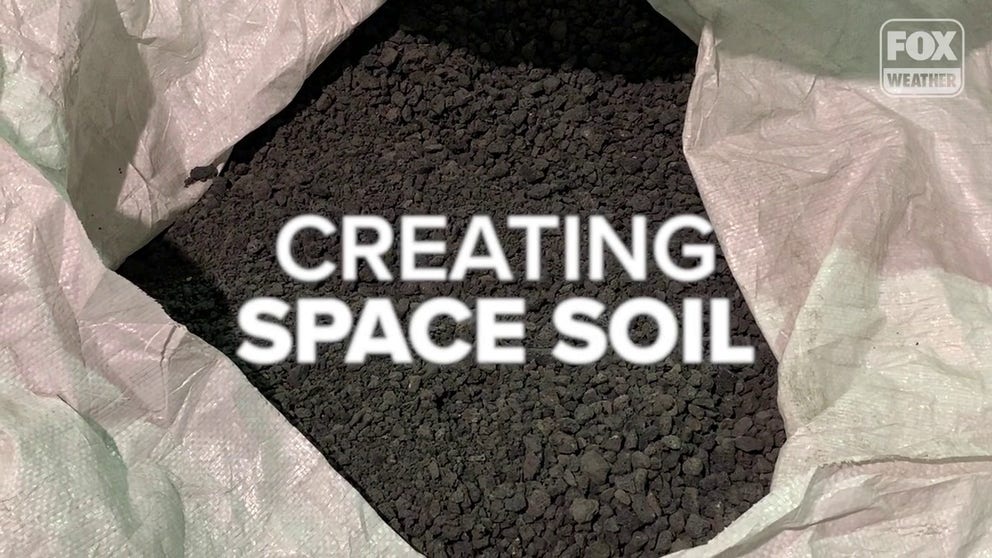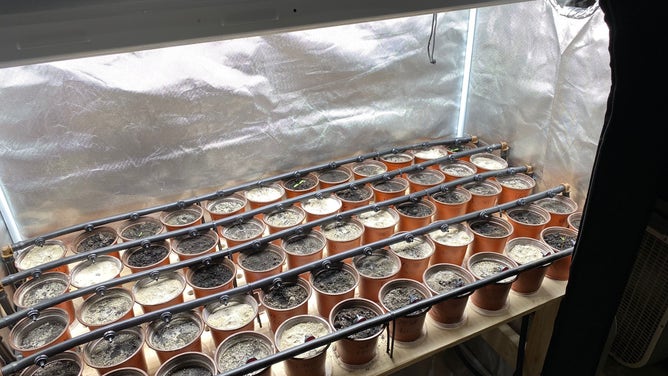The business of space dirt: Artificial lunar, Martian and asteroid soil is in demand
UCF’s Exolith lab is producing simulated moon dirt and will soon build a giant ‘sand box’ to test rovers and landers
Exolith Lab: Creating moon, Mars soil
UCF’s Exolith lab is producing simulated moon dirt and will soon build a giant ‘sand box’ to test rovers and landers.
OVIEDO, Fla. – On a recent day outside the Exolith Lab facility, dozens of neatly wrapped packages sit on a cart outside a nondescript building near the University of Central Florida, awaiting pick up by the U.S. Postal Service.
Inside are vials and bags of manufactured moon and Mars dirt that will be shipped around the country to institutions and schools, furthering research or inspiring students to want to become the next Mars rover engineer.
Commercial space companies are on the verge of sending robots to the moon for NASA ahead of plans to return humans to the moon by 2025. The surge in interest to go back to the moon, this time to stay, is driving the need for moon dirt.
‘THE REAL DEAL’: KENNEDY SPACE CENTER'S NEW IMMERSIVE JOURNEY INTO FUTURE OF SPACEFLIGHT
Accessing the Apollo lunar sample collection is not granted to just anyone. It can take years of applications before a few grams of the precious lunar regolith is awarded to hopeful researchers or educators. But for companies building rovers, landers and rockets bound for the moon, they need lunar dirt by the metric ton.

Packages at UCF's Exolith Lab of lunar and Mars simulant are ready to be shipped out to schools, laboratories and other facilities. (Image: Emilee Speck/FOX Weather)
(FOX Weather)
This is where facilities like UCF’s Exolith Lab come in, capable of producing lunar, Martian and asteroid soil simulants in vast quantities.
"Understanding how do you deal with this dirt that's really quite different than what we encounter on the Earth because there's no water, there's no wind, there's no rain. So the particles are much pointier, much more hazardous and can damage equipment in different ways," explains Josh Colwell, a co-investigator at UCF’s Center for Lunar & Asteroid Surface Science.
Output and demand grows
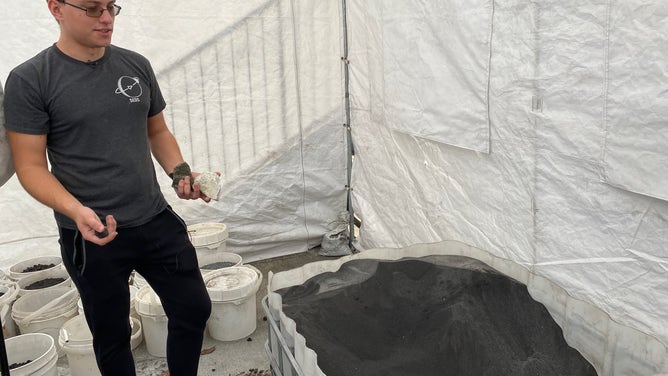
Exolith Lab operations manager Konrad Krol shows how materials are ground down to make lunar and Mars regolith. (Image: Emilee Speck/FOX Weather)
(FOX Weather)
Exolith Lab operations manager Konrad Krol shows where the materials that make lunar and Mars regolith are ground down using mining equipment and then churned in cement-style mixers to get the consistency just right.
HOW TO WATCH FOX WEATHER ON TV
He holds a rock in each hand, showing what the material started as, placing it in bins of the final product.
Krol, a UCF industrial engineering major, estimated that just a few years ago the lab was making regolith simulants in quantities of 5 to 10 kilograms a month. Now, the space dirt business is booming.
"As we've been able to achieve these rates of supplying the industry so quickly, the demand has grown, obviously, as researchers have seen that we're able to appropriately meet their demand," Krol said.
Last year, the team shipped 37 metric tons (37,000 Kilograms) of simulants and can turn around a few tons in a matter of days, including creating 2 tons of simulant for a shipment to Australia in two months. The lab works with customs brokers on international orders.
Around the corner from where the regolith is refined is a makeshift mailroom with shelves loaded with samples pre-packaged by the pound or in small clear jars.
CLIMATE CHANGE MIGHT BE KEEPING YOU FROM A GOOD NIGHT’S SLEEP, STUDY FINDS
"Teachers love putting these up and encouraging our students about STEM and space," Krol said opening a box containing several vials of simulants. The Exolith Lab partners with high schools in the Orlando area, providing educational materials to teachers.
The lab has a high school volunteering program, during which students can earn hours towards the Bright Futures scholarship.
"We're able to bring in a lot of high schoolers and safely show them what it looks like to work in an industrial lab," Krol said.
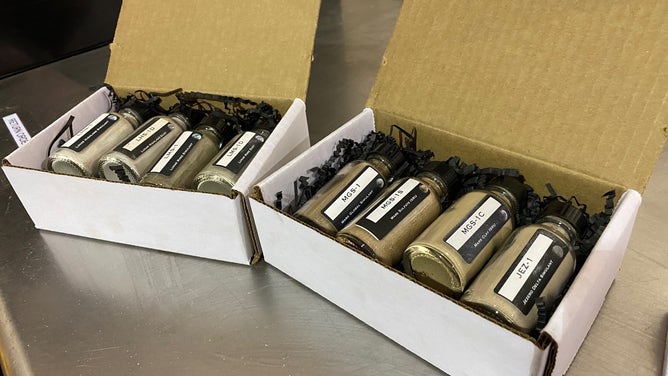
Small bottles of Lunar Mare Simulant, Lunar Highland Simulant and Mars simulant at UCF's Exolith Lab in Oviedo, Florida. Packages like these are popular with schools and educators.(Image: Emilee Speck/FOX Weather)
(FOX Weather)
Some of the most popular products are Lunar Mare Simulant and Lunar Highland Simulant. The lunar simulant can be further broken down to make moon dust.
"So you look up at the sky on the moon, and you see the lighter material, the darker material. And those are the two key products that we're focused on making," said UCF planetary scientists Hannah Sergeant, who uses the simulants for her research.
A Jezero Delta simulant was used for testing on NASA’s Perseverance which is currently roaming the Jezero Crater on the red planet.
As an at-cost organization, the lab sells what it takes to run the business and is primarily funded by UCF’s Center for Lunar & Asteroid Surface Science. After operating out of a storage unit for years, in October 2021, the team moved into a 55,000-square-foot facility down the road from UCF’s main campus.
Coming soon: A giant sandbox for moon rovers
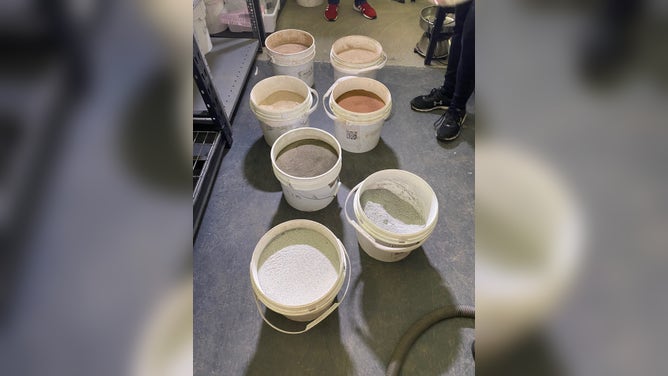
Buckets of Lunar Mare Simulant, Lunar Highland Simulant, moon dust and Mars simulant at UCF's Exolith Lab in Oviedo, Florida. The lab produces the simulated moon and Mars dirt for researchers and educators. (Image: Emilee Speck/FOX Weather)
(FOX Weather)
Woodworking and mining equipment and massive bags for storing regolith are placed around the open building. Soon a giant "sandbox" will be constructed, taking up 32 feet by 32 feet and containing 130 metric tonnes of regolith. It will be one of the largest testbeds for moon robots that is accessible to anyone who wants to reserve the space.
Exolith Lab chief engineer Lucas Weber, a UCF aerospace graduate, calls himself the "babysitter for the bin." He points to where the wood frame will go and where a claw machine-style crane will lift 1/6th a rover’s weight, simulating the moon’s gravity as it moves across the sandpit.
SHE WASN'T ALLOWED TO STUDY ASTRONOMY -- THEN, SHE BECAME A NASA SCIENTIST
"It will have a viewing platform around the outside of it, so we can have researchers walk around and view their experiment," Weber said showing the layout of the design.
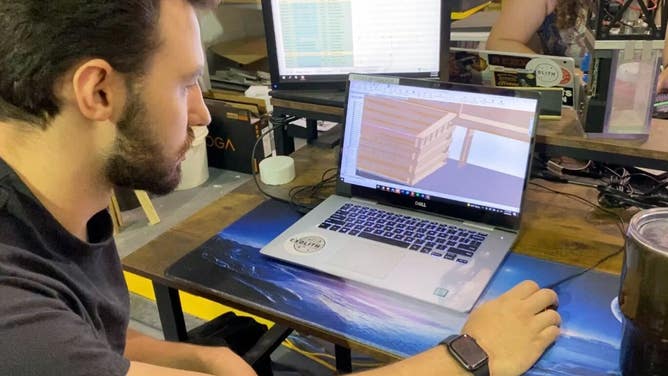
Exolith Lab chief engineer Lucas Weber shows a rendering of the future Exolith bin that will be a testing ground for planetary rovers and landers. (Image: Emilee Speck/FOX Weather)
(FOX Weather)
The giant bin will serve as a proving ground for drilling techniques on the moon. Scientists believe astronauts can use water ice on the moon to create fuel or drinking water. Companies will be able to drive lunar rover wheels, testing new designs that can sustain the abrasive moon dust.
Exolith conducts its own In-Situ Resource Utilization (ISRU) research, practicing how resources on the moon such as dirt, available sunlight and water can be used to create supplies astronauts will need. ISRU research also focuses on how astronauts will live on the moon, Mars and possibly mine asteroids.
"Just walking around, we kick up giant clouds of sand and dirt, creating hazards for astronauts or instruments," Colwell said of the moon. "The Exolith lab is obviously providing a tremendous resource, enabling people to carry out these research projects using really accurate simulants, really accurate representations of what astronauts and robots will encounter when we go back to the moon and go to asteroids."
Using lunar resources for fuel, farming and water
Sergeant is studying how to access water and oxygen on the moon. Using Exolith simulants, she is working on something called molten regolith electrolysis.
"This is where you basically melt moon dust and put electricity through it, and that separates all of the individual ingredients," Sergeant explains. "Including the precious oxygen that we need for crews to breathe and for rocket propellant. We can also extract different metals that we can use to help build structures."
Sergeant said ISRU research is key to unlocking human exploration of the solar system.
"We need to be able to use resources locally to support a base, to support the crew. And so we work with the simulated material here to test those different reactions and extraction processes to access this precious material that we want to use in space," Sergeant said.
CLICK HERE TO GET THE FOX WEATHER UPDATE PODCAST
Steven Elsaid, a UCF biology major, is growing French marigolds in lunar simulant. "They flower all year long, they're edible, and they're really resistant to all kinds of stressors," he said.
He built a tiny greenhouse with lights and an irrigation system. His research and others like it will help eventually cultivate crops in space.
"It's really expensive to bring anything to space and in order to create sustainable farming," Elsaid said. "If we couldn't do it with just what's up, there would require a lot of material moved up into space that would just cost a lot of money just for fuel."
